kadriver
Hazard to Others
  
Posts: 196
Registered: 7-11-2012
Location: United States
Member Is Offline
Mood: Thankful
|
|
Stainless Steel Bowl as the Cathode
I modified my electrolytic silver cell to use a non-magnetic stainless steel bowl as the cathode for the silver cell.
Instead of using a hard graphite block in the bottom of a 1 liter beaker, I am using the entire stainless steel bowl as the cathode.
I just clip the negative lead right to the edge of the bowl (plus I put several jumper wires to even out the flow around the entire bowl).
I did not discover that one could use the bowl as the cathode, the idea was given to me by my gold refining sponsor, and from info provided by members
of another forum.
With the glass cells, I was using a PC powder supply to run the cells. I replaced that with a nice variable power supply capable of putting out up to
10 amps and 30 volts.
With the graphite cathodes and 1 liter glass beakers, all the flow I could get through the cells was about 0.3 amps at the maximum (with electrolyte
concentration at 120g of pure silver dissolved in 1 liter of liquid).
By eliminating the graphite and using the whole stainless steel bowl as the cathode, I am able to push 1.8 amps through the cell (the electrolyte
concentration is 600 grams of silver dissolved in 3.5 liters of liquid = 171.4 grams per liter).
I am going to increase the concentration of the silver nitrate electrolyte to around 300 grams per liter and push even higher amperage (up to 7 or 8
amps) through the cell.
The amperage does the work of dissolving the anode bars that sit in the anode basket. The greater amps means faster anode bar dissolution, which means
faster cell operation, which means I get paid quicker.
I can get 50 troy ounces of silver in 1 week with this configuration. The glass cells with graphite cathodes would take about two weeks to make 50
troy ounces.
Plus, the glass cells were wired in series (the two cells produced more silver per unit of time over just running one glass cell). This series
configuration caused problems with disparity of parameters in the two cells. This disparity has vanished with the stainless bowl configuration.
The silver crystal growth is quite beautifull, looks like a bowl full of diamonds in ocean water (the electrolyte is blue because some dissolved
copper was added to aid crystal growth).
Stainless Steel Bowl non-magnetic (from K-mart about $9 USD) 8.75 inches (222.25 mm) ID at top, 5.5 inches (140 mm) tall.
White cover that holds the anode basket - 3/8 inch (9.5 mm) thick cutting board - 1$ at a yard sale
Anode basket - Rubbermaid food container with holes drilled in the botom - about $3.
Anode filter bag - dacron wet vac vacuum cleaner bag custom cut to fit in the anode basket - $8 at Lowes hardware.
Distance from bottom of anode basket to bottom of the bowl - 4 inches (102 mm). This distance is critical and should be maintained between 4 to 4.5
inches (102mm to 115mm).
Electrolyte capacity - about 3.7 liters
Electrolyte concentration - 171.4 grams pure silver dissolved in 1 liter of liquid.
Solvent used to dissolve the silver - dilute nitric acid (1:1 conc HNO3 and distilled water)
Anode bars - 99.0% pure silver (sterling dissolved in dilute nitric then cemented with clean copper, washed, dried, cast into bars)
Voltage parameters 1.5v DC to 3.8v DC - outside these parameters other metals may tend to plate out with the silver causing contamination of your pure
silver.
Amps - as much as you can safely push through!
Cheers,
kadriver
Edited once to add anode to cathode distance

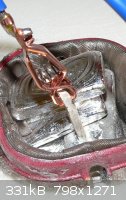
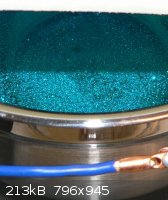
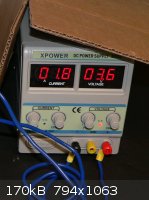
[Edited on 16-2-2013 by kadriver]
|
|
|
DONALD W
Harmless

Posts: 7
Registered: 15-2-2013
Member Is Offline
Mood: No Mood
|
|
Nice set-up.
Where did you get your variable power supply. Seen similiar on ebay but only 5amps.
Wonder if a food type of drainer (collander) would do the same.
|
|
|
smaerd
International Hazard
    
Posts: 1262
Registered: 23-1-2010
Member Is Offline
Mood: hmm...
|
|
Very nice set-up!
|
|
|
cyanureeves
National Hazard
   
Posts: 737
Registered: 29-8-2010
Location: Mars
Member Is Offline
Mood: No Mood
|
|
would this work with silver coins composed of 80% silver and 20% copper? since they already have copper in the coins. by the way i am trying this with
15% silver brazing rods that i melted down and it is hard to get it conductive.i should've just kept them as rods because now it has a shell of some
glass type flux. i have a coin that doesnt have much value other than the silver and was thinking of melting it down.
[Edited on 2-17-2013 by cyanureeves]
|
|
|
KonkreteRocketry
Hazard to Others
  
Posts: 165
Registered: 12-11-2012
Location: Dubai
Member Is Offline
Mood: No Mood
|
|
Any one knows if pencil lead can be used in eletrolysis to prevent corrosion ?
|
|
|
kadriver
Hazard to Others
  
Posts: 196
Registered: 7-11-2012
Location: United States
Member Is Offline
Mood: Thankful
|
|
Quote: Originally posted by DONALD W  | Nice set-up.
Where did you get your variable power supply. Seen similiar on ebay but only 5amps.
Wonder if a food type of drainer (collander) would do the same. |
Here is the exact one I have 30 volts 10 amps;
http://www.ebay.com/itm/30V-10A-10AMP-3010D-Pro-Digital-DC-P...
A collander would work. But the distance between the bottom of the anode basket and the bottom surface of the bowl is critical (so i have been told)
and must be maintained between 4 to 4.5 inches (102mm to 114mm).
Kadriver
|
|
|
kadriver
Hazard to Others
  
Posts: 196
Registered: 7-11-2012
Location: United States
Member Is Offline
Mood: Thankful
|
|
Quote: Originally posted by cyanureeves  | would this work with silver coins composed of 80% silver and 20% copper? since they already have copper in the coins. by the way i am trying this with
15% silver brazing rods that i melted down and it is hard to get it conductive.i should've just kept them as rods because now it has a shell of some
glass type flux. i have a coin that doesnt have much value other than the silver and was thinking of melting it down.
[Edited on 2-17-2013 by cyanureeves] |
Hello,
According to the info I have been given, the anodes should be kept above 90% purity. Below this level, the dissolved copper would increase rapidly and
foul the cell rather quickly.
The cell will tolerate about 60 grams per liter of dissolved copper, after that the copper will begin to plate out on your pure silver, ruining the
purity of the silver crystals.
It would be best (with both your coin and braze) to first digest these items in dilute 1:1 nitric acid, filter to remove solids - save the solids
because they could contain gold or platinum groups - then cement the silver with clean copper (I use freshly stripped copper wire or copper pipe cut
open to make it flat).
The 15% brazing rod is probably alloyed with copper (and possibly some other metals) but should digest nicely in dilute nitric. Once in solution, the
silver can be selectively removed by adding clean copper to the solution, the other metals (lower on the reactivity series list) will remain in
solution.
Cementing the silver with clean copper is an effective refining step to get the pure silver out of an alloy.
Wash the "cement" silver with boiling distilled water, dry and melt it into anode bars for the silver cell. The cement silver will be about 99% pure
or greater depending on your technique.
And unless you are doing this just to gain the experience and knowledge, the coins are best left alone because they contain a known quantity of silver
(if they are us coins). Once you dissolve these and convert them to pure silver, their value becomes questionable unless you develop a reputation for
producing pure metals.
Hope this helps
Kadrive
|
|
|
kadriver
Hazard to Others
  
Posts: 196
Registered: 7-11-2012
Location: United States
Member Is Offline
Mood: Thankful
|
|
Pencil lead is soft graphite. It should work OK anywhere graphite is a recommended electrode.
Kadriver
|
|
|
smaerd
International Hazard
    
Posts: 1262
Registered: 23-1-2010
Member Is Offline
Mood: hmm...
|
|
Pencil lead wears very quickly in my experience.
|
|
|
kadriver
Hazard to Others
  
Posts: 196
Registered: 7-11-2012
Location: United States
Member Is Offline
Mood: Thankful
|
|
Here is a short video of the cell after it has been operating for about a week.
The pure silver crystals cling to the inner surface of the bowl as they are plated out from the electrolysis.
I used a bamboo skewer (relatively non-reactive with a sharp tip) to dislodge the crystals from the bowl.
They come off quite easily and just fall to the bottom of the bowl.
After scraping, I reassembled the cell and turned the current back on.
I have about 30 troy ounces of additional impure (about 99.0% purity) anodes to dissolve through the anode basket.
I should have about 80 troy ounces of pure silver when the feed stock is consumed.
But then the real fun starts - getting the gold and platinum group metals left behind in the anode bag.
Silver is a carrier of gold and platinum metals, and they can be recoverd easily from the operation of the electrolytic silver cell.
http://www.youtube.com/watch?v=fvjZ_EH-yDM
Thanks for looking!
kadriver
|
|
|
morganism
Hazard to Others
  
Posts: 105
Registered: 8-12-2012
Location: Az.
Member Is Offline
Mood: No Mood
|
|
I'm going the same route.
Just got a big , 50 cup , group coffepot , in stainless , for the same use.
And i can heat to 100c , because its a percolator too.
Look for the double wall insulated ones....
|
|
|
kadriver
Hazard to Others
  
Posts: 196
Registered: 7-11-2012
Location: United States
Member Is Offline
Mood: Thankful
|
|
I cleaned out the silver cell this evening.
It took about 5 minutes.
The electrolyte (the blue liquid on the left) will be augmented with some more silver nitrate, filtered and then reused for my next batch of silver.
The beaker on the left contains about 70 troy ounces of pure silver crystal - at least 999 fine (but probably closer to 9999).
The slimes from the anode bag should yield a few grams of pure gold and a bit of platinum group metals.
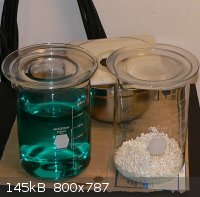 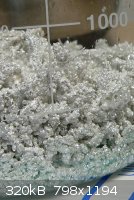
thanks for looking - kadriver
|
|
|
kadriver
Hazard to Others
  
Posts: 196
Registered: 7-11-2012
Location: United States
Member Is Offline
Mood: Thankful
|
|
Here is the final product from the stainless silver cell.
There is 73.4 troy ounces of pure silver crystal in that bowl.
Took exactly two weeks to produce this amount with my tiny silver cell.
It assayed at 99.9% pure elemental silver metal.
I had the cell back in operation in just minutes after harvesting these crystals.
kadriver
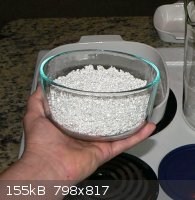
|
|
|
preeti22
Unregistered
Posts: N/A
Registered: N/A
Member Is Offline
|
|
wonder about how stainless steel bowl used as cathode??? but nice set up.
|
|
|
elementcollector1
International Hazard
    
Posts: 2684
Registered: 28-12-2011
Location: The Known Universe
Member Is Offline
Mood: Molten
|
|
Where do you get so much silver nitrate?
Also, how's the anode sludge coming along? Any gold, platinum, etc.?
Elements Collected:52/87
Latest Acquired: Cl
Next in Line: Nd
|
|
|